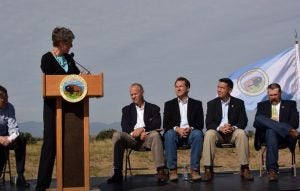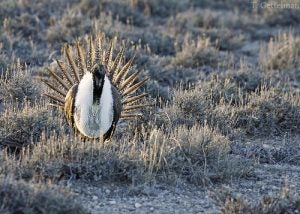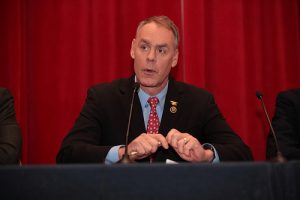
Western governors, landowners, conservationists and others celebrated the collaborative and bipartisan conservation effort that led to a “not warranted” listing decision for sage-grouse in September 2015.
Today, the Interior Department opened up federal sage-grouse plans to potential changes, despite the concerns of many state, industry, landowner and conservation stakeholders across the country.
John Swartout, a senior policy advisor to Colorado Governor John Hickenlooper, said that it would be bad for Colorado if the sage-grouse plan, developed over years with local and state involvement, was eliminated, for fears that this would lead to a future Endangered Species Act listing.
“We didn’t work this hard to throw it all away and get a listing,” he said, echoing concerns of others that upending the plans could ultimately lead to the sage-grouse being listed.
Wyoming Governor Matt Mead reiterated what many western governors have told Secretary Zinke – that the states should be consulted about revisions to the plans because they are ultimately the ones who have to face the consequences if the plans fail and a federal listing is warranted.
“If it was a state by state listing decision, that’d be one thing,” Mead said. “But the way we are with the law right now, if one state gets listed, we all are going to get listed. We sink or swim together.”
Impending disaster, or possible lifeline
Western governors like Hickenlooper and Mead have continued to show great bipartisan leadership on sage-grouse conservation efforts. If the plans are significantly altered or rescinded, these leaders and countless other ranchers and local stakeholders will be left to deal with great uncertainty and risk.
Altering the plans could have immediate and significant negative consequences on the ground:
- Landowner-led efforts would be disrupted, including revenue-earning opportunities from sage-grouse conservation programs.
- Millions of dollars invested in sage-grouse conservation programs would be held up.
- Robust agriculture and energy industries would lose the clear and consistent standards that they rely on to operate and to confidently plan for the future.
- Outdoor recreation and tourism sectors that benefit from roughly $1 billion a year in economic output driven by sage-grouse habitat would suffer, including countless jobs and livelihoods.
Ultimately, any move to undermine the sage-grouse plans would put short-term industry profits over the long-term viability of the western landscape and way of life. But it’s not too late to keep the plans intact.

The U.S. Fish and Wildlife Service mitigation policy was updated in fall 2016 to make new tools available in the conservation toolbox, including market-based approaches that increase flexibility, efficiency and effectiveness.
Secretary Zinke should follow the lead of western governors, ranchers and other stakeholders who have created robust, science-based, and consistent plans to keep the bird off the Endangered Species List. Let’s keep the plans in place, and keep the bird off the list.
The next storm is brewing
The greater sage-grouse is a canary in the coal mine. It’s a sign of a declining sagebrush ecosystem. It’s also a sign of a greater political fight ramping up on the mitigation front.
When it comes to disaster preparedness, mitigation is the effort to reduce loss of life and property by lessening a disaster’s impact. According to the Federal Emergency Management Agency (FEMA), “in order for mitigation to be effective we need to take action now—before the next disaster—to reduce human and financial consequences later.”

In June, Interior Secretary Ryan Zinke called compensatory mitigation “un-American” during his keynote speech at the Western Governors’ Association meeting – a sign that the politicization of wildlife management will not end with sage-grouse. (Photo credit: Gage Skidmore)
The same rule applies to mitigation for impacts to wildlife.
The fundamental rule of effective wildlife mitigation policy is that environmental harm should be avoided, minimized and restored. And, when possible, mitigation should take place prior the impact, just as in disaster preparedness, to minimize the damage. Unfortunately, these fundamental rules are now being sidestepped on the administration’s march towards energy dominance above all else. It’s a short-sighted strategy that will bring long-term consequences for our nation’s great wildlife, landscapes and economy.
We can’t set the precedent that collaborative efforts and common sense solutions won’t withstand politics. We need to take the long view, to respect the process, to honor the agreements that have been made, and to realize that ecosystems are forever.
Future generations of wildlife and people depend on it.
Related:
A bird has united thousands. It will not divide us. >>
What’s next for the greater sage-grouse? A public lands strategy >>
Ranchers and conservationists step up to avert listing of sage-grouse >>









